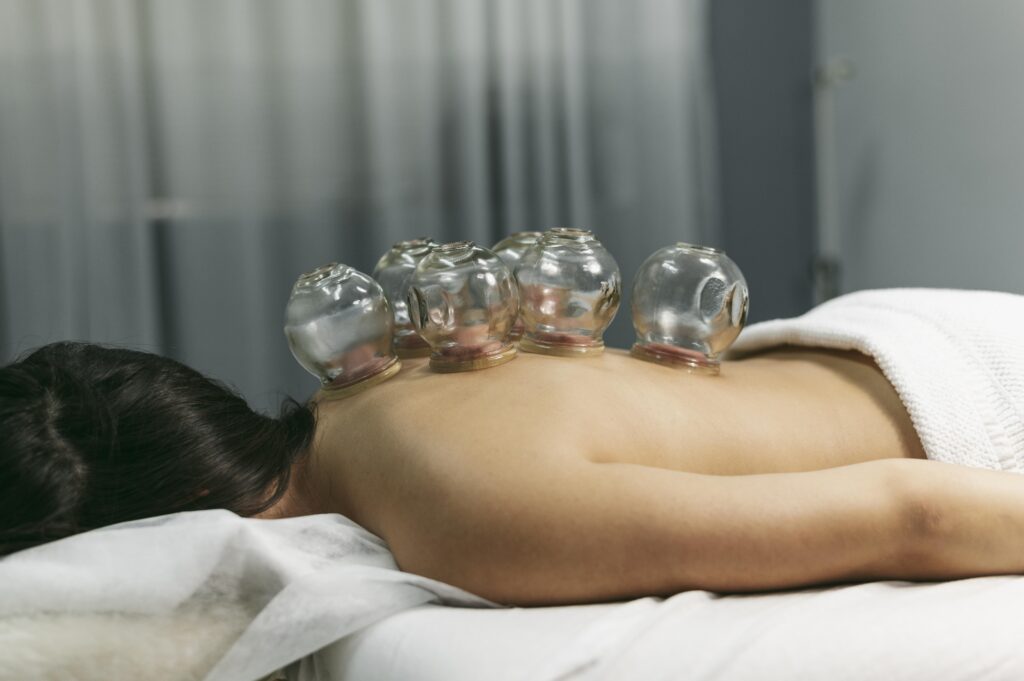If you're exploring alternative wellness treatments, cupping therapy offers a time-tested approach that may benefit your health in meaningful ways. This ancient practice involves placing suction cups on the skin to improve blood flow, reduce muscle tension, and support the body's natural detoxification processes.
Many people seek guidance from the best massage therapist to learn whether cupping might complement their wellness routine. The therapy works by stimulating your body's natural healing mechanisms, which can reduce inflammation, strengthen immunity, and speed up recovery from injuries.
This comprehensive approach addresses ailments ranging from musculoskeletal pain and respiratory issues to anxiety. With different cupping techniques available and proper safety considerations in mind, you can experience the benefits of improved circulation and better well-being. Cupping therapy opens new possibilities for health improvement.

Cupping therapy has been utilized for centuries across different cultures as a traditional healing practice to promote health and wellness. This ancient therapy dates back to Egyptian, Chinese, and Middle Eastern civilizations. In Egypt, cupping was used to treat fever and other common ailments. Chinese medicine views cupping as a way to balance the body's yin and yang, promoting the flow of qi energy.
In the Middle East, cupping was believed to detoxify the body and improve circulation. Throughout history, cupping therapy has evolved and been adapted by different cultures, each adding its unique touch to the practice. Understanding the rich history of cupping therapy provides insight into the profound impact it has had on health and well-being over the centuries.
Understanding the mechanism of cupping therapy involves recognizing how the application of suction to the skin creates a therapeutic effect on the body's tissues and systems. When the cups are placed on the skin and the air inside is heated or suctioned out, the underlying tissue is gently drawn upwards, promoting increased blood circulation to the area. This improved blood flow helps to reduce muscle tension, release toxins, and stimulate the lymphatic system.
Cupping is believed to trigger a localized inflammatory response, which can aid in healing processes by bringing immune cells to the targeted area. The combination of these effects results in reduced pain, improved relaxation, and better well-being.
Cupping therapy offers a range of health benefits that stem from its ability to increase blood circulation and stimulate the body's natural healing mechanisms. Promoting better blood flow to the targeted areas helps reduce inflammation, ease muscle tension, and improve relaxation. This therapy also helps to detoxify the body by drawing out toxins and waste products from the tissues, leading to a revitalized feeling.
Cupping is known to strengthen the immune system, making the body more resilient to illnesses. The increased blood flow and oxygen delivery resulting from cupping can contribute to faster healing of injuries and aches. Incorporating cupping therapy into your health routine can provide multiple benefits for your well-being.
Treating numerous conditions, cupping therapy has been utilized to address ailments ranging from musculoskeletal pain to respiratory issues. This traditional therapy has shown efficacy in managing conditions such as back pain, neck pain, migraines, and rheumatoid arthritis. Cupping is also commonly used to improve circulation, reduce inflammation, and alleviate symptoms of respiratory conditions like asthma and bronchitis.
It has been employed to aid in digestive disorders, skin problems, and even anxiety and fatigue. Creating suction and promoting blood flow helps cupping relieve muscle tension, improve energy flow, and support better well-being. Understanding the diverse range of conditions that cupping therapy can effectively address showcases its potential as a comprehensive treatment option.
Utilizing specialized cups and different techniques, practitioners of cupping therapy employ specific methods to create suction and promote healing in the body. The cups used can be made of glass, silicone, or plastic and come in different shapes and sizes. Traditional methods involve heating the cups to create a vacuum effect when placed on the skin, while modern techniques may use pumps to create suction. There are two primary cupping techniques: stationary cupping, where cups are placed on specific points and left for a few minutes, and moving cupping, where oil is applied to the skin, and the cups are moved around the affected area. These techniques, coupled with the right tools, aim to stimulate blood flow and alleviate health issues.
When considering cupping therapy, understanding the safety measures and important considerations associated with this alternative healing practice is crucial. Cupping, while generally safe, requires attention to certain details to guarantee a positive experience. Choosing a certified practitioner is the starting point; verify that your cupping therapist is certified and experienced in the technique.
Before beginning treatment, discuss your complete medical history with your therapist, including any medical conditions or medications you are taking. Cupping should not be performed on areas with cuts, bruises, or skin lesions, so your therapist will examine your skin beforehand.
Hydration plays a significant role in the effectiveness of cupping, so drink plenty of water before and after your session. After treatment, monitor your skin for any adverse reactions and report them to your practitioner if they occur. Following these safety guidelines will help ensure a beneficial cupping therapy experience.
Related Topics: